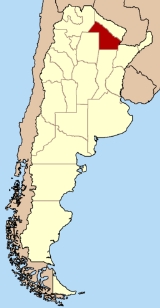
Lule language
Encyclopedia

Argentina
Argentina , officially the Argentine Republic , is the second largest country in South America by land area, after Brazil. It is constituted as a federation of 23 provinces and an autonomous city, Buenos Aires...
.
Lule may be extinct
Extinct language
An extinct language is a language that no longer has any speakers., or that is no longer in current use. Extinct languages are sometimes contrasted with dead languages, which are still known and used in special contexts in written form, but not as ordinary spoken languages for everyday communication...
today. Campbell (1997) writes that in 1981 there was an unconfirmed report that Lule is still spoken by 5 families in Resistencia
Resistencia, Chaco
Resistencia is the capital and largest city in the province of Chaco, in northeastern Argentina. At the 2001 census, the population of the Resistencia city proper was 274,490 inhabitants. It is the anchor of a slightly larger metropolitan area, Greater Resistencia, which comprises three more...
in east-central Chaco Province
Chaco Province
Chaco is an Argentine province located in the north of the country, near the border with Paraguay. Its capital is Resistencia on the Paraná River opposite the city of Corrientes...
.
It is unclear if it is the same language as Tonocoté.
Genetic relations
Lule appears to be distantly related to the still-spoken Vilela languageVilela language
Vilela is a nearly extinct language which is only spoken in the Resistencia province of Argentina and in the eastern Chaco near the Paraguayan border. Dialects were Ocol, Chinipi, Sinipi; only Ocol survives...
, together forming a small Lule–Vilela
Lule–Vilela languages
-External links:*Alain Fabre. 2005. Diccionario etnolingüístico y guía bibliográfica de los pueblos indígenas sudamericanos....
family. Kaufman (1990) finds this relationship likely and with general agreement among the major classifiers of South American languages. Viegas Barros published additional evidence 1996–2006. Zamponi (2008) and other authors consider Lule and Vilela two linguistic isolates.
There were three distinct groups known as Lulé:
- The nomadic Lule of the plains, who in addition to their own language, spoke Tonocote, the local lingua franca and the language of Spanish catechism.
- The sedentary Lule of the foothills, who were trilingual in Lule, Tonocote, and Quechua in addition to their original language, CacánCacán languageCacán is an extinct language that was spoken by the Diaguita and Calchaquí tribes in northern Argentina and Chile. It became extinct during the late 17th century or early 18th century. The language was documented by the Jesuit Alonso de Bárcena, but the manuscript is lost...
. - The Lule-Tonocote, whose language was recorded by Machoni.
Data
In 1586 Father Alonson Bárzana (Bárcena) wrote a grammar of Tonocote, which is now lost. In 1732 Antonio Maccioni (Machoni), who was not aware of Bárzana's grammar, wrote one of his own, Arte y vocabulario de la lengua lule y tonocoté ('Art and vocabulary of the language of the Lule and Tonocote') of the Lule-Tonocote language at the mission San Esteban de Miraflores. This is our primary data on the language. Métraux (1946) concluded that Lule and Tonocote were distinct, and perhaps unrelated, languages, and that the Tonocote at the Miraflores mission had shifted to the Lule language by the time of Machoni.Machoni records a language with vowels /a e i o u/ and few consonants. Final syllables are stressed. There are consonant clusters in initial and final position: quelpç [kelpts] 'I split', slimst [slimst] 'I blow my nose', oalécst [walekst] 'I know', stuç [stuts] 'I throw'.
External links
- Proel: Lengua Lule
- Proel: Familia Lule–Vilela

